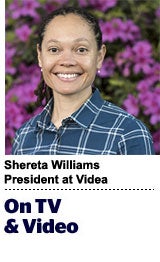 “On TV And Video” is a column exploring opportunities and challenges in advanced TV and video.
“On TV And Video” is a column exploring opportunities and challenges in advanced TV and video.
Today’s column is written by Shereta Williams, president at Videa.
The rise of over-the-top (OTT), video on demand and other nonlinear TV options has dramatically increased the number of viewers who consume content through services like Netflix or Hulu.
These advancements have driven new demands in TV advertising that cannot be addressed without organizational and cultural change. This is especially challenging in organizations that might be hesitant to change because their tried-and-true practices have always seemed to work before.
But with the emergence of new consumer devices, channels and platforms, the TV industry must be able to easily and accurately identify content across platforms and have an open industry standard for recognition.
Voluntary guidelines created within the marketplace to ensure demand and inventory are represented fairly will improve the selling of broadcast linear TV and supplemental first-party data needed to understand audience value. Open standards require a fundamental change to overcome traditional practices and doing so together as an industry.
Taking full advantage of the transformative evolution underway means that broadcasters should be driving change at an accelerated pace to keep up with the new demands. Driving change means first accepting and acknowledging there might be better, more effective ways of selling local TV inventory and proactively encouraging and supporting teams in exploring new options.
How Real Change Takes Form
Broadcasters, who find themselves at the wheel of a changing business, have the opportunity to become the leaders of change by guiding their entire organizations through the adoption and implementation of the technologies that will mark the future of TV.
From abandoning manual processes for automated cloud-based options for buying and selling inventory, to implementing ATSC 3.0 across various channels, it is key for broadcasting executives to be aware of how these changes might affect and be perceived by the company’s different constituents. Broadcasters must leverage their leadership and communication skills to translate change across different generational and operational groups within the organization.
They must take the time to educate each group through training sessions about technology usage, capabilities and the promise of how it can simplify their future needs. Broadcasters must also take the time to define how the strategy of the group will align with future needs of both consumers and advertisers.
For this reason, broadcasters hold the key to the future of TV. And the future looks bright on the other side of change for anyone who’s willing to take the first step.
Letting Technology Work For The Team
As technology keeps advancing, broadcasters have the opportunity to automate processes that have traditionally been done manually. This can free up resources from redundant processes and allow broadcasters to refocus their work in new and strategic ways.
Broadcast leaders need to identify technological advancements that best fit their needs and goals and adopt them across their whole organization. I would recommend creating a team or committee to help drive the charge of vetting and assessing key technologies and attributing solid goals to make the most promising possibilities a reality.
Translate, Train And Maintain
Once new technologies have been introduced and processes automated, broadcasters need to ensure ample communication about the value they deliver to the organization. Departments also need to be approached from a distinct and individual perspective for training.
As processes evolve over time and the technology improves, ongoing training will require new updates to ensure that the company and its teams are adapting and leveraging the technology to its full potential.
Monitor For Effectiveness And Growth
Lastly, as a dynamic broadcasting industry is bound to constantly evolve, it is vital to always keep an eye on the future. Closely monitoring consumer trends and engagement in relation to technological changes underway will help broadcasters adapt quicker and keep up with evolving consumer demands.
Broadcasters need to continually monitor and evaluate this process to ensure that they remain competitive and stay ahead of the curve. This will also help to underscore the importance of technology and leadership’s commitment to advancing the future of local TV.
Follow Videa (@VideaLLC) and AdExchanger (@adexchanger).












